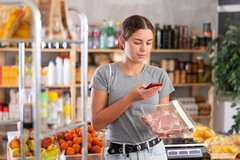
- Industry news
Industry news
- Category news
Category news
- Reports
- Key trends
- Multimedia
- Journal
- Events
- Suppliers
- Home
- Industry news
Industry news
- Category news
Category news
- Reports
- Key trends
- Multimedia
- Events
- Suppliers
DTM Print speeds up personalization on baked goods with edible ink printer update
20 Apr 2021 --- DTM Print is introducing faster and larger printing options on its edible ink desktop printer called Eddie, which creates personalized designs on baked goods and dessert items.
The specialty printing systems provider has launched a manual feed option along with custom food trays for the printer. The initial automatic carousel feeder allows Eddie to print personalized designs and messages on candy and baked goods one at a time. The maximum diameter is 89 mm and 20-25 mm in height.
However, the new manual mode extends these parameters to a maximum of 120 mm and allows thicker items with a maximum height of 27 mm.
“Normally when using the manual feed, you can print just one item at a time as you place the print object on the lever,” Katrin Hoffmann, public relations at DTM Print, tells FoodIngredientsFirst.

“But DTM Print especially developed trays for foods such as macarons, chocolate lentils and marshmallows that allow you to print onto multiple objects in one run.”
Personalization during the pandemic
In general, personalization is “all the rage” in today’s consumer and B2B markets, says Hoffmann. Individualized confectionery and baked goods are ideal for promoting company logos at tradeshows and corporate events, edible souvenirs at amusement parks or zoos, as well as private social gatherings.
As the pandemic has restricted such private and commercial events, one might think bespoke merchandise are also less in demand.
DTM Print’s specialty trays are designed for printing multiple larger items like macarons in one run.“But personalized gifts are still in high demand whether in the B2C or B2B market. Companies still request sweets with their corporate logo to send as gifts to their clients,” Hoffmann explains.
Many customers using the Eddie printer offer their confectionery and baked goods online, specifically to customize them for seasonal holidays, such as Easter, Valentine’s Day, Mother’s Day or Halloween.
Innova Market Insights predicted innovative technologies would spur personalization’s popularity in 2021 with its top F&B trend “Tailored To Fit.” Technological advances and the ever-expanding choice in foodservice and retail are combining to allow consumers to adopt a more individual approach to eating.
Manual versus automatic
Eddie can print on a range of food items, including cookies, candy, white chocolate, biscuits, marshmallows and chocolate lentils.
The new manual mode’s expanded diameter proves “especially important” for printing on macarons, a French confection consisting of soft fillings sandwiched between two meringue-based cookie halves.
The manual feed allows for various shaped and sized trays to be swapped out.However, all parts put together are too high for a complete macaron to be printed with the automatic feed. By using the manual feed and a “macaron tray,” bakers and pastry chefs can save time by printing on finished macarons.
With the automatic feed, a carousel plate holding up to 12 food items is attached to the printer. A lever then transports the print items from the carousel into the printer, which then automatically adjusts the height and prints the objects. After printing, they are then placed back on the carousel.
In contrast, the new manual feed does not have the carousel plate attached. “Instead, you can either place your print item directly onto the lever or use one of the many different trays that are placed onto the lever,” Hoffmann details.
Food-safe inks
DTM Print affirms Eddie is the “first-and-only” NSF and Good Manufacturing Practice (GMP)-certified edible ink desktop printer.
“The ink has been certified by the US Food and Drug Administration and also has EU approval for use as a food additive. That makes Eddie one of the safest direct-to-food printers,” Hoffmann adds.
To print on food, Eddie only uses one three-color ink cartridges that contain the following dyes:
- Cyan: lue No. 1 - Brilliant Blue FCF (E133)
- Magenta: Carmoisine - Azorubine (E122)
- Yellow: Yellow No. 5 - Tartrazine (E102), Yellow No. 6 - Sunset Yellow FCF (E110)
For bespoke detailed prints, the surface should be dry for the ink to work best.What isn’t Eddie suitable for?
Despite its function as a food printer, Eddie does not replace conventional labels on fruits and vegetables. “For those applications, DTM Print offers color label printers,” notes Hoffmann.
Conventional foods with labels directly on them are typically fresh fruits and vegetables. These labels can range widely, conveying brand names, adherence to standards or added barcode and retailer information.
“Those applications require industrial grade dimensions,” Hoffmann flags, noting Eddie cannot print on millions of food items daily.
“Eddie is a printer for small to medium runs. It’s perfect for bakeries and confectionery businesses that create and design their own sweets, offer personalization and value quality over mass quantity.”
However, Eddie can still also print barcodes, text and logos onto confectionery and baked goods. The Eddie manual feeding update ultimately arrives to “give customers as much printing flexibility as possible,” says Hoffmann.
“We have so many creative customers using Eddie. We wanted to allow them to be even more creative.”
By Anni Schleicher











